
The Daimler Company Limited, prior to 1910 The Daimler Motor Company Limited, was an independent British motor vehicle manufacturer founded in London by H. J. Lawson in 1896, which set up its manufacturing base in Coventry. The company bought the right to the use of the Daimler name simultaneously from Gottlieb Daimler and Daimler-Motoren-Gesellschaft of Cannstatt, Germany. After early financial difficulty and a reorganisation of the company in 1904, the Daimler Motor Company was purchased by Birmingham Small Arms Company (BSA) in 1910, which also made cars under its own name before the Second World War. In 1933, BSA bought the Lanchester Motor Company and made it a subsidiary of Daimler Company.

The Daimler 2.5 V8/V8-250 is a four-door saloon which was produced by The Daimler Company Limited in the United Kingdom from 1962 to 1969. It was the first Daimler car to be based on a Jaguar platform, the first with a unit body, and the last to feature a Daimler engine after the company was bought from the Birmingham Small Arms Company by Jaguar Cars in 1960. The engine is the hemispherical head V8 designed by Edward Turner and first used in the Daimler SP250 sports car.
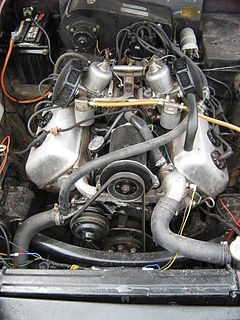
Daimler V-8 engines were designed for the Daimler Company by Edward Turner and produced from 1959 to 1969. Initially used in the SP250 sports car and the Majestic Major saloon, the engine was mostly used in the Daimler 2.5 V8 saloon made with Jaguar Mark 2 unit bodies from 1962 to 1969. Approximately 20,000 of the 2.5-litre version of the engine were made for use in the SP250 and the 250 saloon, while approximately 2,000 of the 4.5-litre version were made for use in the Majestic Major saloon and its limousine variant which remained in production until 1968.

The Daimler SP250 is a sports car built by the Daimler Company, a British manufacturer in Coventry, from 1959 to 1964. It was the last car to be launched by Daimler before its parent company, the Birmingham Small Arms Company (BSA), sold it to Jaguar Cars in 1960.

The Daimler Majestic DF316/7 and DF318/9 luxury saloon was launched by the Daimler Company of Coventry in July 1958 and was in production until 1962. Edward Turner had been appointed Chief Executive of BSA Automotive in 1957 and promised new products, this car was to carry his new V8 engine still under development. The six-cylinder, four-door saloon, with new three-speed Borg Warner automatic transmission, power steering and vacuum-servo assisted four-wheel disc brakes was mechanically up-to-date for its time, but it had a heavy coachbuilt body of outdated construction on a separate chassis which kept the car's mass well above more modern designs and made it difficult to manoeuvre, despite the modern steering. The styling was already becoming outdated when the car appeared and became increasingly dated as lighter cars with monocoque construction appeared during the Majestic's production run.

Hooper & Co. was a British coachbuilding business for many years based in Westminster London. From 1805 to 1959 it was a notably successful maker, to special order, of luxury carriages both horse-drawn and motor-powered.
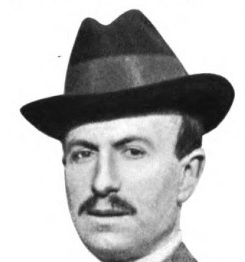
Frederick Richard Simms was a British mechanical engineer, businessman, prolific inventor and motor industry pioneer. Simms coined the words "petrol" and "motorcar". He founded the Royal Automobile Club, and the Society of Motor Manufacturers and Traders.
Norah Docker, Lady Docker was an English socialite. A dance hostess at a club in her youth, she married three times, on each occasion to an executive of a business that sold luxury goods. Her third marriage, to Sir Bernard Docker, the chairman of Birmingham Small Arms Company (BSA) and its subsidiary, Daimler, was notable for the couple's extravagant lifestyle. This was often funded by tax writeoffs and company expenditure that could not be legitimately defended, which led to Sir Bernard's removal from BSA's board of directors. She was also banned from Monaco by Prince Rainier after an incident in which she tore up a Monegasque flag.
Sir Bernard Dudley Frank Docker was an English industrialist. Born in Edgbaston, Birmingham, he was the only child of Frank Dudley Docker, an English businessman and financier.
Daimler Airway was an airline subsidiary of the Birmingham Small Arms Company (BSA)'s Daimler Company. It was created to use some of the assets of the failed ventures Airco and its subsidiary, Aircraft Transport and Travel, which was acquired by BSA in February 1920.

The Daimler New Fifteen, was a large saloon/sedan car at the low end of the manufacturer’s range, announced in September 1937. It had a tax rating of 16.2 hp. In September 1938 it was given a larger engine with the tax rating of 17.9 hp though it retained the name Fifteen. When production resumed in 1946 it was given a revised cylinder head, given chrome channel frames for the side-windows, stripped of its running-boards, and renamed Daimler Eighteen.
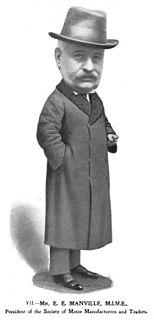
Sir Edward Manville M.Inst.E.E., was a British consulting electrical engineer, industrialist and politician.
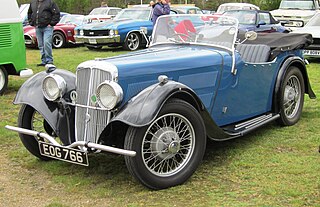
BSA cars were manufactured between 1907 and 1912 in Birmingham then until 1939 in Coventry as well as Birmingham, England. BSA had established a motor-car department in an unsuccessful effort to make use of the Sparkbrook Birmingham factory. An independent part of the same site was occupied by The Lanchester Motor Company Limited. Sales were handled by BSA Cycles Limited. After 1912, manufacture was carried out by group subsidiary Daimler in Coventry or BSA Cycles in Birmingham.
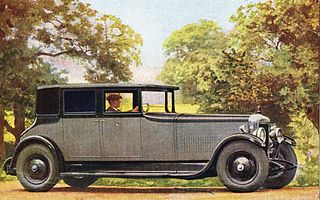
Daimler Double-Six piston engine was a sleeve-valve V12 engine manufactured by The Daimler Company Limited of Coventry, England between 1926 and 1938 in four different sizes for their flagship cars.
The Critchley Light car was briefly manufactured by Daimler Company of Coventry in 1899 to find use for about 50 unwanted 4 h.p. engines shipped to Coventry by the German Daimler works at Stuttgart. The car was well regarded and sold well but was not intended to extend Daimler's range of high-powered expensive motorcars. As such, it was named Critchley after James S. Critchley Daimler's works manager

Daimler Straight-Eight engines were eight-cylinder in-line petrol engines made by the Daimler Company to power the largest and most expensive cars in their range. The Straight-Eight engines replaced Daimler's earlier Double-Six V12 engines. Unlike the Double-Six engines, which used sleeve valves based on the Knight patents, the Straight-Eights used conventional poppet valves in the overhead valve configuration.

Daimler DE was a series of chassis made by the Daimler Company from 1946 to 1953. DE chassis were the basis for Daimler's largest and most expensive cars at the time. There were two versions: the short-wheelbase DE 27 with the Daimler Twenty-seven six cylinder engine, and the long-wheelbase DE 36, the last Daimler Straight-Eight, with the Thirty-six straight-eight engine. Daimler DEs, especially the DE 36 Straight-Eight, was sold to royalty and heads of state around the world, including British royalty under the royal warrant that Daimler had held since 1900.

The Docker Daimlers were cars built for display at the British International Motor Show at Earls Court Exhibition Centre from 1951 to 1955. The cars were built on Daimler chassis by Hooper, a Daimler subsidiary, on the order of Sir Bernard Docker, chairman of Daimler and managing director of parent company Birmingham Small Arms Company (BSA), and his second wife, Lady Docker, who had been made a director of Hooper by Sir Bernard.

State and royal cars of the United Kingdom are kept at the Royal Mews, Buckingham Palace. A distinction is kept between the State Cars and other vehicles.















